Thursday, 27 April 2017
| Room 313A |
08:15 - 10:15 |
Moderators: Xiaoping Hu, Paula Foster |
Slack Channel: #s_mrs_molecular
Session Number: O48
08:15
|
1027.
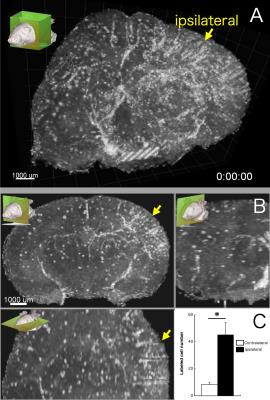 |
Quantitative four-dimensional motility tracking of individual immune cells in living mouse brain 
Yuki Mori, Daniela de la Mora, Atsuki Tashita, Syoji Kobashi, Ikuhiro Kida, Yutaka Hata, Yoshichika Yoshioka
Improved imaging techniques are being used to broaden the scope and better understanding of the complex cell behaviours in the body. Nonetheless, the migratory behavior of immune cells after CNS injury is still poorly understood. In this study, we employed four-dimensional (4D) MRI to monitor the dynamic migration of infiltrating monocytes/macrophages in the living mouse brain. Our results demonstrate the possibility of non-invasive long-term monitoring of individual live cells. Moreover, this innovative technique furthers our understanding of the cellular mechanisms occurring in the normal and injured brain tissues.
|
08:27
 |
1028.
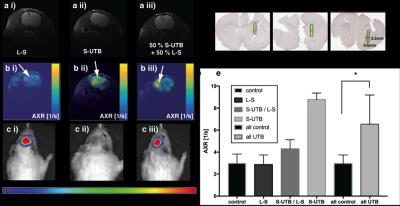 |
A gene reporter detected using MRI measurements of reporter-mediated increases in transmembrane water exchange 
Franz Schilling, Susana Ros, De-En Hu, Paula D'Santos, Sarah McGuire, Richard Mair, Alan Wright, Elizabeth Mannion, Robin Franklin, André Neves, Kevin Brindle
Non-invasive imaging of gene expression can be used to track cells in vivo but often requires the addition of an exogenous contrast agent that may have limited tissue access. We show that the urea transporter (UT-B) can be used as a gene reporter, where reporter expression was detected using 1H MRI measurements of UT-B-mediated increases in plasma membrane water exchange. AXR values measured in UT-B-expressing HEK cell xenografts, were significantly higher compared with non-expressing controls. Transduction of rat brain cells with a lentiviral vector expressing UT-B resulted in a ≈ 2-fold increase in AXR at the site of virus injection.
|
08:39
 |
1029.
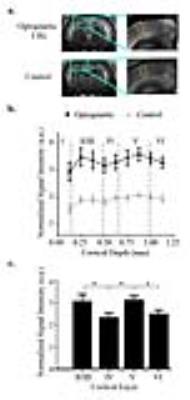 |
Brain-wide Interaction of Low Frequency Hippocampal Activity with Layer-specific Cortical and Subcortical Regions: An Optogenetic Manganese-enhanced MRI Study 
Yongrong Qiu, Leon C. Ho, Russell W. Chan, Alex T.L. Leong, Xunda Wang, Celia M. Dong, Ed X. Wu
The hippocampus, including the dentate gyrus (DG), and the sensory cortices, which consist of six distinct layers, have reciprocal connections with the entorhinal cortex (EC). However, the low frequency hippocampal-cortical interactions and layer-specific cortical responses remains largely unknown. Combining the optogenetic stimulation and manganese-enhanced MRI, the present study revealed layer-specific responses of sensory cortices and EC involvement in hippocampal-cortical interactions during low frequency stimulation, but not high frequency, at dorsal DG. In summary, we demonstrated an effective combination of optogenetic stimulation and manganese-enhanced MRI to uncover the frequency-dependent and cortical layer-specific responses involved in brain-wide interactions.
|
08:51
 |
1030.
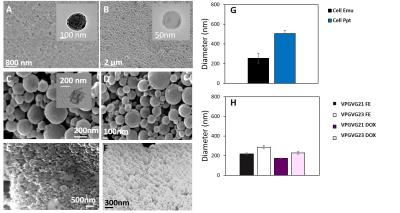 |
Novel Polymer and Peptide REACTION-based Theranostics for MRI. - permission withheld
Laura Szkolar Sienkiewicz, Dorela Shuboni-Mulligan, Christiane Mallett, Erik Shapiro
MRI offers a unique opportunity for theranostic agent development. By engineering both polymer and peptide materials, we have scope to successfully target, image and treat a range of biological conditions. Here we successfully demonstrate the use of targeted and triggered nanoparticles, encapsulating imaging and chemotherapeutic agents, as theranostics for MRI.
|
09:03
 |
1031.
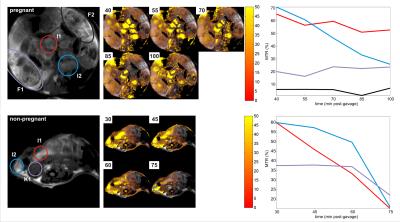 |
Maternal and fetal glucose uptake followed by chemical exchange saturation transfer imaging (glucoCEST) on pregnant mice at 21.1T 
Stefan Markovic, Jens Rosenberg, Shannon Helsper, Tangi Roussel, Michal Neeman, Samuel Grant, Lucio Frydman
GlucoCEST generates a contrast that is sensitive to glucose uptake and metabolism. While previously shown with tumor models, a distinct glucose metabolism is also characteristic of pregnancy. This study explores the potential of glucoCEST under this condition. Glucose was administered to pregnant mice by gavage in a manner akin to that used in human pregnancy-induced diabetes tests, and subsequently monitored in-vivo by glucoCEST at 21.1T. Distinct differences were apparent upon instituting glucose, with organ-specific glucoCEST contrast exceeding 50-70%. Notable imaging differences were noted between dame and fetuses upon glucose gavage, as well as between pregnant and non-pregnant animals.
|
09:15
 |
1032.
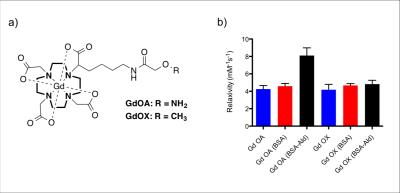 |
Molecular MR imaging of pulmonary fibrogenesis using the novel probe GdOA - permission withheld
Philip Waghorn, Chloe Jones, Clemens Probst, Diego Ferreira, Nicholas Rotile, Howard Chen, Andrew Tager, Peter Caravan
Fibrogenesis is a feature of idiopathic pulmonary fibrosis (IPF) that leads to the increased deposition and cross-linking of collagen. There remains a demand for non-invasive imaging of fibrogenesis in patients with suspected IPF to deliver earlier diagnoses and monitor treatment response. One universal feature of fibrogenesis is the oxidation of lysines on collagen to form allysine, which is a fundamental component for the cross-linking of collagen. We developed GdOA, a Gd-based MR probe that targets allysine as a marker for active fibrogenesis. We demonstrate that GdOA MR signal enhancement correlates with extent of disease and is sensitive to therapeutic response.
|
09:27
 |
1033.
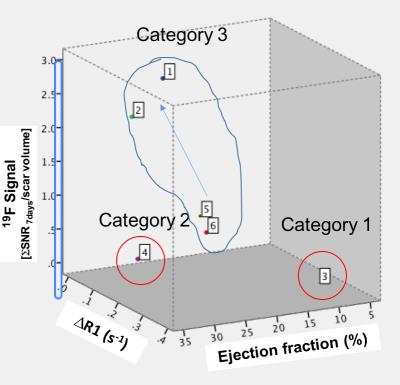 |
Molecular imaging of inflammation and extracellular matrix remodeling in a murine model of myocardial infarction 
Isabel Ramos, Markus Henningsson, Maryam Nezafat, Begońa Lavin, Silvia Lorrio, Alkystis Phinikaridou, Ulrich Flögel, Ajay Shah, René Botnar
A suitable degree and timely resolution of inflammation and extracellular matrix (ECM) deposition are requirements for optimal healing and remodeling after myocardial infarction (MI). In this study, we explored the merits of multinuclear 1H/19F MRI for the simultaneous assessment and quantification of cardiac inflammation and elastin deposition in a murine model of MI. 19F containing particles, uptaken by macrophages, were used to investigate inflammatory cell recruitment into injured myocardium and an elastin-specific MR contrast agent was used to evaluate changes in elastin content in the ECM post-MI.
|
09:39
 |
1034.
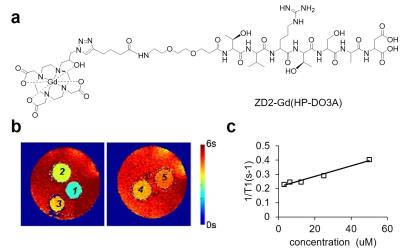 |
MR molecular imaging of extradomain-B fibronectin for characterizing prostate cancer aggressiveness - permission withheld
Zheng Han, Sarah Roelle, Yuchi Liu, Xin Yu, Zheng-Rong Lu
Accurate risk stratification is critical to the clinical management of prostate cancer. The objective of our study is to investigate the effectiveness of MR molecular imaging of EDB-FN for non-invasive localization and characterization of prostate cancer aggressiveness. An EDB-FN targeting Gd-based contrast, ZD2-Gd(HP-DO3A), was designed and synthesized. Molecular MRI of EDB-FN with ZD2-Gd(HP-DO3A) can specifically improve contrast enhancement in high-risk prostate tumors, not low-risk tumors, enabling accurate characterization of prostate cancer aggressiveness. Molecular MRI with the contrast agent has great promise for detection of high-risk prostate cancer, and non-invasive differential diagnosis and risk stratification of human prostate cancer.
|
09:51
|
1035.
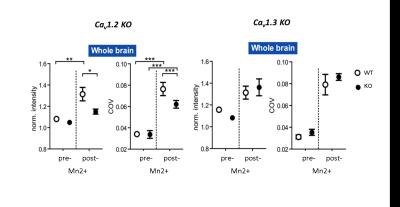 |
The Role of the L-type calcium channel Cav1.2 in MEMRI 
Benedikt Bedenk, Suellen Almeida-Correa, Carsten Wotjak, Michael Czisch
L-type voltage-dependent Ca2+ channels of type Cav1.2, but not Cav1.3, are essential for Mn2+ accumulation in MEMRI. Cav1.2 conditional knock-out animals were exploited to show that a bias exists towards Mn2+ accumulation in axon terminals and highly dense output structures. Our results have strong implications for the analysis of activity dependent Mn2+ accumulation.
|
10:03
|
1036.
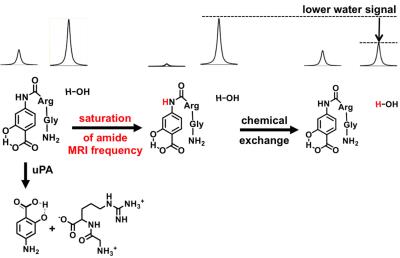 |
Detecting in vivo urokinase Plasminogen Activator activity with a catalyCEST MRI contrast agent 
Sanhita Sinharay, Christine Howison, Amanda Baker, Mark Pagel
SYNOPSIS: We have designed a nonmetallic contrast agent, GR-4Am-SA, that can detect the activity of urokinase Plasminogen Activator with CEST MRI. uPA cleaves a peptide of the agent which causes CEST at 5.0 ppm to decrease, but CEST at 9.5 ppm is unchanged. The two CEST signals were used to determine a reaction coordinate, representing the extent of enzyme-catalyzed cleavage of the GR-4Am-SA agent. GR-4Am-SA detected uPA activity in solution, and in a flank xenograft model of Capan-2 pancreatic cancer.
|
|












